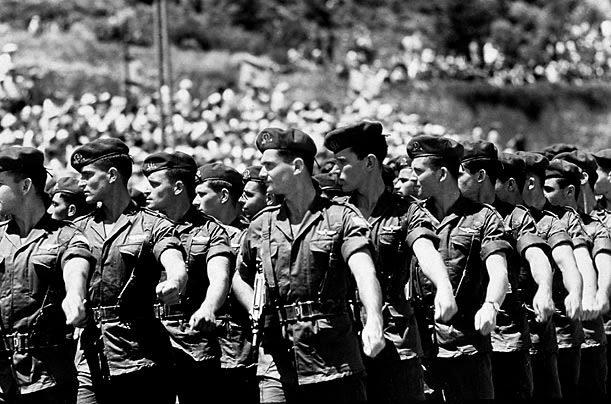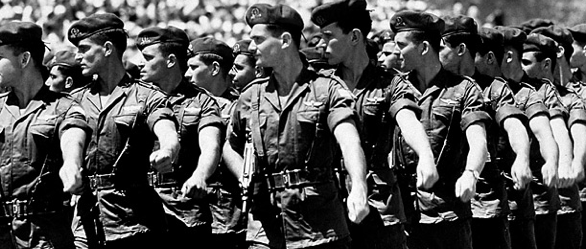In 1968, in the wake of the Six-Day War, we registered for the Rabbinical Council of America summer tour of the Holy Land. We arranged for our youngest daughter to stay with Malkah’s parents, Ceil and Sam Grund. Our two elder daughters, seven and five at the time, accompanied us. We traversed the length and breadth of the country. Never again would we see so much of Israel in such a short period of time. The aftermath of the Six-Day War was still tangible on every street corner. Signs and posters abounded declaring “More power to the Israel Defense Forces.” The average Israeli exuded confidence and pride. We were amazed at the different types of Jews we encountered. Their skin color, native languages, and social deportment ran the gamut of human reality. Yet there was a basic feeling of people-hood and joint destiny that united all of us. Nowhere was this more tangible and manifest than at the Western Wall. We prayed there the Friday nights we were in Jerusalem and on Tishah B’Av. We had never seen so many Jews united in prayer as we witnessed that Tishah B’Av. During the course of the fast, tens of thousands worshiped at the Wall.
My first concrete step towards aliyah was to register with the Israel Aliyah Center, which was sponsored by the World Zionist Organization. The office was located at 515 Park Avenue in a structure that was popularly known as the Jewish Agency building. When I explained that I was a rabbi, the aliyah counselor informed me that rabbis sweep streets in Jerusalem. When I told him that I also possessed a doctorate in Jewish history, I was told that such individuals work in Jerusalem’s Biblical Zoo. I later learned that these discouraging assertions were part of a coordinated effort by the Aliyah Center to weed out undesirable applicants. It seems that immediately following the Six-Day War there was a marked upsurge in aliyah from North America. However, among the newcomers there were individuals who were not attuned to the Israeli facts of existence. Some became a burden to the local society while others simply returned to the States after benefiting from Israeli largess. Despite the cold water that was figuratively poured upon me, my enthusiasm was not dampened. I filled out the form and listed my education and life experiences.
One piece of information that I wrote in a perfunctory fashion turned out to be decisive. I mentioned that my doctorate on Rabbi Bernard Revel was under contract to be published in a revised form by the Jewish Publication Society. When my application was forwarded to the Israeli counterpart of the Aliyah Center, this achievement became paramount. Unknown to me, a major literary and scholarly project was progressing in Israel. After World War I, German Jewish intellectuals planned a new encyclopedia in the German language. The work, entitled Encyclopedia Judaica, moved forward on a high level of scholarship. Once the Nazis rose to power, its publication had to be suspended after volume 10, which completed the letter L. The hardships and tribulations of these troubled times brought to a premature end the final achievement of German Jewish scholarship.
Dr. Nahum Goldmann, the last active survivor of the original editorial board of the German Encyclopedia Judaica, took the initiative in reviving its publication. The new process culminated with the publication of the English-language Encyclopedia Judaica. Goldmann obtained an allocation from the German reparations fund designated for cultural purposes. The preliminary work began in the United States with the main editorial offices in Philadelphia. The first editor in chief was Professor Benzion Netanyahu of Philadelphia’s Dropsie College. Professor Cecil Roth became the editor in chief in 1966. The editorial center was transferred to Jerusalem, the center of Jewish scholarship and Roth’s home. He settled in Jerusalem after he retired from his position as reader in Jewish Studies at Oxford University in his native England.
By now the preparation of the new encyclopedia became more urgent and earnest. The publishing responsibility was assumed by the Israel Program for Scientific Translations. At the time it was an Israeli government corporation. It later was privately owned and began diversifying its publishing program. It subsequently established the Keter Publishing House, under whose imprint the encyclopedia was published. The entire operation was directed by Mr. Yitzchak Rischin, who came to the States to interview possible candidates for employment in Jerusalem. My background caught his eyes and an interview was set up for the Fast of Esther, March 3, 1969, at the Jewish Agency building. Rischin presented me with a contract at the conclusion of our session. I requested a short time extension so I could talk it over with Malkah. The next day, Purim, I signed the contract and made my commitment.
Thus began a race against time to get everything in order before we would sail to the Holy Land. I informed my congregation, and helped start the process of selecting the next rabbi. We had to sell our house in Maplewood and arrange the overseas move of our belongings and personal possessions. We began speaking only Hebrew in our house so our children would become more familiar with the language. Little did we realize that in only a few months hence we would speak only English at home so our children would retain a means of communication with their grandparents. I stopped shaving with the arrival of sefirah since I felt that one had to be more traditional in appearance to reside properly in the Holy City of Jerusalem. Soon enough the day of departure arrived. All the farewells to family, friends, congregants, and students were behind us. We boarded the Queen Anna Maria of the Greek Line at Pier 97, located at West Fifty-Seventh Street in Manhattan on June 23, 1969. All arrangements were made by the Israel Aliyah Center. As this was during the period of the increased North American aliyah, the Jewish Agency concluded that it was more economical to charter a portion of a boat than to send the olim by air.
The voyage was pleasant and the majority of the passengers were olim. There was a feeling of spiritual exultation as the boat brought us closer and closer to Israel. We felt privileged to be returning home after close to two millennia of exile. There was the mystical sensation that we represented all the generations that preceded us and imparted the love of Zion to us. There were many children among the olim, and they too were caught up in the significance of this juncture in their blossoming lives. They played, studied, and prayed, enveloped by the atmosphere of preparation for what would be an unfamiliar and new lifestyle.
On Saturday, July 5, the majestic Haifa coastline came into sight. The boat remained offshore until the conclusion of the Sabbath. We then docked, disembarked, and took our first steps as permanent residents on the holy soil. Israeli television, which was then in its infancy, awaited us. We were the largest group of North American olim to arrive together. I was selected to say a few words on behalf of the new¬comers. I observed the Jewish Agency representatives, seated behind long tables, ready to process us and introduce us to Israeli officialdom. I simply stated that we were overjoyed to be here. We recognized that proper bureaucratic procedures were a necessity. Nonetheless, if the Messiah should appear now, we should be allowed to exit immediately. The senior Jewish Agency official present happily agreed to the request. Nevertheless, it took us a few more hours until we finally entered the vehicle that was designated to take us to Jerusalem. The Messiah did not come, but we were finally on the highway toward our new home. On all subsequent Israeli documents, we would record our birth dates and the date of our aliyah, July 5, 1969.
We finally entered the Holy City at around 4 a.m. We were exhausted but decided to go to the Kotel for our initial prayers in the Holy City. We quickly placed our luggage in the small apartment that was assigned to us. Malkah’s brother Yaakov, who had settled in Jerusalem in 1966, drove us to the Kotel, where we observed the sunrise over the Western Wall, the last remnant and constant reminder of Israel’s glory of old. This time we were no longer tourists and there was comfort in the thought that we would be able to worship at the Kotel on a continuous basis. Indeed I was to organize my own Friday-night minyan at the Western Wall, which became popularly known as the Young Israel of the Kotel.
Adapted from Rabbi Rakeffet’s memoirs From Washington Avenue to Washington Street. Learn more about this book and obtain a pre-publication discount at OU Press.
The words of this author reflect his/her own opinions and do not necessarily represent the official position of the Orthodox Union.

